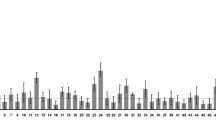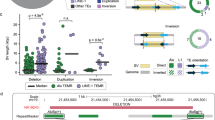Abstract
The EWS gene has been identified as being systematically translocated in Ewing’s sarcoma. In order to ascertain the basis of a marked interethnic difference in the incidence of Ewing’s sarcoma, intron 6 of EWS, which is located near the translocation breakpoint region (EWSR1), was characterized. Sequence analysis of the entire intron 6 region revealed a very high density of Alu elements. Most of these Alu sequences could be classified in previously described subfamilies, facilitating delineation of an evolutionary model that involves successive retroposition events. According to this model, the EWS intron 6 region progressively expanded until about 5 million years ago. More recently (105 years ago), in part of the human population, the size of this region decreased by over 50% as the result of a homeologous recombination between two Alu sequences, which removed 2480 bp. This rare allele has only been observed in individuals of African origin, a population that is characterized by the lowest incidence of Ewing’s sarcoma.
Similar content being viewed by others
Author information
Authors and Affiliations
Additional information
Received: 12 June 1996 / Revised: 1 September 1996
Rights and permissions
About this article
Cite this article
Zucman-Rossi, J., Batzer, M., Stoneking, M. et al. Interethnic polymorphism of EWS intron 6: genome plasticity mediated by Alu retroposition and recombination. Hum Genet 99, 357–363 (1997). https://doi.org/10.1007/s004390050372
Issue Date:
DOI: https://doi.org/10.1007/s004390050372




